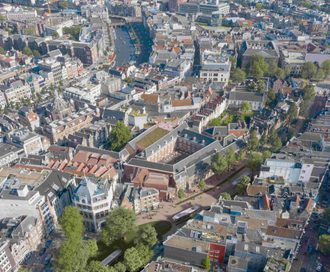A new city museum
The main location of the Amsterdam Museum is housed in a beautiful monumental building in the city centre on the Kalverstraat: the former Burgerweeshuis.
Since the opening of the main location there in 1975, the Amsterdam Museum has been known as a progressive city museum where activities and exhibitions are organised on various subjects for and by Amsterdammers. The city and its inhabitants are always the protagonists. Historical and contemporary (art) objects and stories are combined and complemented with the creativity and critical eye offered by contemporary artists. Which makes the museum an important public place for encounters in the center of the city.
The location at the heart of the historic city center and the building’s rich history make the former Burgerweeshuis the ideal place for the city museum of the future. After all, the building is our most important collection piece. Yet substantial improvements are needed in order to realize the museum’s ambitions here for future generations as well.
The design by Neutelings Riedijk Architecten is based on four principles: space for the collection and the public, accessibility, visibility, and sustainability.
The Amsterdam Museum is the cultural figurehead of the city. There are so many museums here, but only the Amsterdam Museum truly belongs to the city and tells the stories of the city.”
Luan Buleshkaj
(word artist and theatremaker)
The new Amsterdam Museum will be an open, friendly place where visitors and inhabitants can get to know Amsterdam in a museum setting that is connected to the neighborhood, the city, and its inhabitants.
The design for the new Amsterdam Museum is based on extensive research into the genesis of the heritage monument’s complex structure, into the historical value of the various parts of the buildings, into the possible reuse of materials from the past, and into embedding itself in the medieval heart of the city center. Inventive, sustainable solutions will transform the hermetic monument into an open museum, with awareness of the history of the building and the location, and of the building itself as the centerpiece of the collection. This means plenty of space for the public, collection, presentations, education, and programming.
Preparations for the renovation are already in full swing. More information about the plans can be found on this website. A detailed brochure and current press information is available for download at the bottom of this page. As time goes on, additional information will be added. If you would like to stay up to date with the latest developments, please subscribe to the newsletter of the Amsterdam Museum.
The history of the Burgerweeshuis
The building on the Kalverstraat has been continuously adapted and remodeled by its users over the past centuries. Throughout this period, it has grown along with the needs of its inhabitants: the nuns of the Sint Luciënklooster, the children of the Burgerweeshuis, and the visitors of the Amsterdam Museum. This heritage monument and its location tell uniquely Amsterdam stories. These are still legible in the building today, whether in the historical configuration of dwellings, in the gates and courtyards, or in the facades designed by Jacob van Campen. All these elements will be preserved in the new design.
The history goes back to the late Middle Ages. Back then, the Sint Luciënklooster, a nunnery dedicated to Saint Lucia, stood on this spot. Its first mention dates from 1414. In the decades that followed, the monastic complex expanded further. That lasted until 1578, the year when the Catholic city government was removed.
The subsequently Protestant city council confiscated the monastic property and distributed it among various charities. The building complex became the property of the Burgerweeshuis, at which time Amsterdam’s orphans took up residence. It remained that way for nearly four centuries, until 1960.
That year, the Burgerweeshuis opened a new home for children on the IJsbaanpad in Amsterdam and the municipality purchased the heritage monument. Following a major renovation, Queen Juliana opened the Amsterdam Historical Museum in 1975, on the occasion of the 700th anniversary of the city.
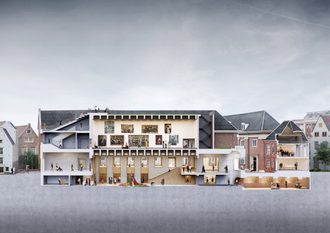
Design and plan
The new Amsterdam Museum will be an open, friendly museum with a clear internal routing and large rooms for the collection, presentations, and temporary exhibitions. It includes multifunctional spaces for education and learning, workshops, discussion, lectures, and other public programs. With its open access on the ground floor and the many windows that face the street and courtyards, it makes a clear connection with the city and its inhabitants.
The design is based on a thorough analysis of the building’s history. The characteristic layout of the heritage monument consists of dwellings situated around courtyards and accessed by a gate. It previously functioned as a “village within the city.” This configuration is still recognizable today, and will be preserved and enhanced in the new design. The new main entrance is situated in the middle of the complex, so all visitors will enter through one of the gates and can discover the courtyards before stepping into the building. The new sections of the building are integrated in the historical structure and match the existing cityscape with their pitched roofs.
At the heart of the design for the new Amsterdam Museum is the establishment of a recognizable entrance, creating a logical internal routing, and adding new museum galleries. This will make the museum a more efficient, spacious, flexible, and sustainable building. The design increases the overall recognizability and ensures the new Amsterdam Museum is an important cultural spot between the Dam and Spui.
The new museum opens toward the city. Previously closed doors are unbolted. The gallery around the Stadshal and the courtyards are accessible to everyone, free of charge. Moreover, the museum is also accessible for persons with reduced mobility. Everyone will soon be able to find their way to and through the new Amsterdam Museum with ease.
Surrounding the courtyards and on the Nieuwezijds Voorburgwal will be public functions such as a museum restaurant, auditorium, and educational spaces. The windows and doors of the heritage monument, which are now often covered and closed, will be opened up again. In this way the museum offers an inviting face to the city and brings life into the courtyards and along the street. The courtyards will form a calm and relaxing spot for visitors and local residents alike. Visitors will also experience the historical value and architectural qualities of the monument.
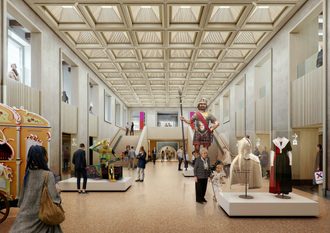
Freely accessible city hall
The public entrance, the Stadshal, facilitates a welcoming access. All visitor facilities will be located here, such as cloakroom, restrooms, museum shop, catering, information desk, and admissions counter. Here, too, will be statues and artworks from the city’s collection. This multifunctional space with its striking staircase will also be used for public programs. The greatly improved museum route begins and ends in the Stadshal.
It's like I'm less lonely. As a gender diverse person, I saw in the Amsterdam Museum for the first time in a museum that I am also part of history.”
Tammie Schoots
student
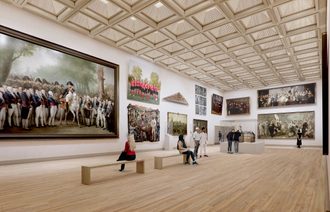
New spaces & improvement of existing spaces
The museum visit, which begins in the central Stadshal, follows an unambiguous, logical, and uninterrupted route along historic spaces and new museum galleries. There are new exhibition halls, two galleries by the Jongenplaats and two galleries by the Sint Luciënsteeg, all spaciously laid out and with good climate control systems. On the first floor, above the Stadshal, is the large new museum hall. This hall offers sufficient space for the largest works from the collection, which previously could not be shown at this location.
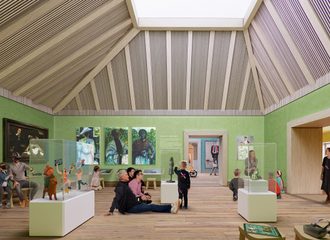
Absent Matter
Education
The new museum has plenty of space for education, workshops, and public programs. This includes the auditorium, various workshop rooms, the education lab, and the project space annex, the story house. School groups can be accommodated in a separate education wing at the Jongenplaats. In the project space and the story house, Amsterdammers can gather with their networks to share their stories about subjects close to their hearts. There, meals can be prepared and enjoyed together.
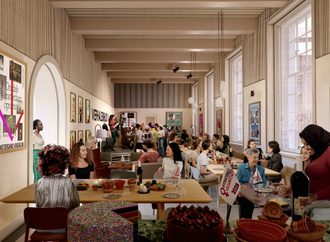
Absent Matter
Storytelling Lab
The Amsterdam Museum is an important podium for inhabitants of the city who want their voices to be heard. Through long-term collaborations with social and cultural organizations, as well as initiatives in the city’s various districts, we can continuously keep our fingers on the pulse and be alerted to topics that are important among local residents – subjects such as migration, gentrification, or the rights of women and LHBTIQ+ people worldwide. The museum has many years of experience with co-creation trajectories in which the input of participating residents is paramount.
The stories from residents are given a permanent place at the new Amsterdam Museum in the Storytelling Lab. Here, Amsterdam residents can come together to make their voices heard and share stories, with the option of enjoying a meal while doing so, because the Storytelling Lab has its own kitchen for everyone to use.
A sustainable museum
The building will soon become more sustainable through a conscientious application and reuse of materials, the installation of energy-efficient systems, and the implementation of sustainable technical interventions where possible. A ground source heat pump will be installed and the building will benefit from better insulation while respecting the heritage value of the facades.
In addition, the building will no longer use gas, becoming far more energy efficient through the utilization of modern technologies. We are looking into how we can make the outdoor spaces greener, capable of catching and storing excess rainwater. A green roof will be created above the Stadshal and main hall, likely planted with mosses and sedum.
The upcoming renovation will use circular construction, where existing building materials are reused as much as possible. This involves distinguishing different material flows. Of particular interest is the preservation of materials from the disassembly phase of the existing building, which can then be reused within the project. In terms of other materials that will become available, such as masonry and roof tiles, the goal is to find a destination for these within the project. In cases where material cannot be extracted from this or another project, new material will be used. It is important that the raw materials for these elements are both circular and environmentally friendly. Also of importance is that the material is reused in subsequent projects at the end of its lifespan.
Contribute to the new Amsterdam Museum
Our goal is clear. The new Amsterdam Museum will soon be there for everyone who feels connected to the city of Amsterdam. But we can only realize this with the support of others. Everyone can help us: governments, funds, foundations, companies and individuals. And every support is very welcome, big or small. Because an investment in the renovation and refurbishment of the Amsterdam Museum, at this special location, is an investment in the future of our city.
Press
Are you a member of the press and do you have any questions about this information, would you like more information or would you like to receive the images shown in high resolution? Please contact the Amsterdam Museum, via pr@amsterdammuseum.nl or via +31 (0)20 5231 822.
Artist impressions
The artist impressions provided by Neutelings Riedijk Architecten are intended to give a general visual impression of the design. The images therefore do not represent an exact representation of the future actualization.
With support of
Main benefactor
Municipality of Amsterdam
Founder
VriendenLoterij
Main Partner Education
ELJA Foundation
Main Patron
J.R. Prins & Y.G. Prins-Blei Weissmann
Van den Tweel Foundation
Chr. P. van Eeghen
Legaat Ruud Heus
Anonieme Grote Gever
Generous Patron
De heer en mevrouw Lindenbergh-Sluis
Anonieme Gulle Gever
Patron
Helen van de Kamp
Hemubo
